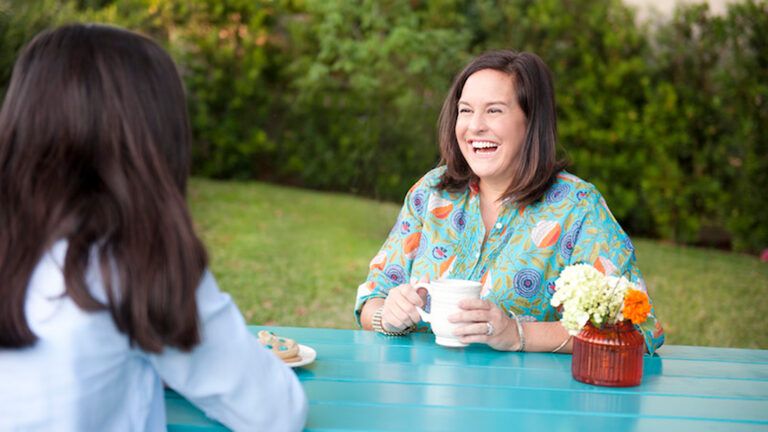Ten years ago, if you told me I’d give up the business I spent my life putting together to go build houses on Indian reservations instead, I’d have said you were nuts. The Seattle-based loungewear company I started with a partner was cranking out a profit. At 33, I’d just married my longtime sweetheart Anita. I wanted to slow down, have a family, savor life and the rewards of success.
Then I saw that headline.
I was in New Mexico on business and picked up a local paper called Indian Country. There it was on the front page, like an epitaph: “Elders Freeze to Death.” How could such a thing happen here in America, the richest country in the world? I tore out the article and stuck it in my pocket.
That night in my hotel room, meetings done, I read the story again. It seemed so tragic. Somebody—the government, the tribal council—would no doubt do something to make sure it did not happen again. Still, I tucked the clipping into my briefcase instead of throwing it away. Why, I had no idea.
Two weeks later, another business trip. Another headline staring at me from the local paper. “Taos Woman Starts Adopt-A-Grandparent Program for Aging Native Americans.” According to the article, on reservations across the country, thousands of elderly Native Americans struggled not just to make ends meet but simply to stay alive. At the end of the piece there was a number for people interested in volunteering to call. I didn’t stop to think. I just picked up the phone and dialed.
Soon I was matched with a “grandparent”—Katherine Red Feather, of South Dakota’s Pine Ridge Reservation. I dropped her a note introducing myself. “I am seventy-eight years old,” Katherine wrote back, “and blessed with 13 children and seven grandchildren. I am so happy to learn I now have another grandchild! Do you have a wife and children of your own? I hope so, as they are one of the most wonderful gifts the Great Spirit can give a person in this life.”
I told her about Anita, and how she was indeed a godsend. Then I asked Katherine if there was anything I could send her. “Yes,” she wrote. “If it’s not too much trouble, I would very much appreciate a bottle of shampoo and some aspirin. Thank you for your generosity, Grandson.”
Grandson… Katherine was really taking this program seriously. But shampoo? Aspirin? Why wouldn’t she have such basic items? I decided to visit the reservation after my next business trip and look in on Katherine.
Pine Ridge Reservation encompasses the two poorest counties in the United States. So the letter from the Adopt-A-Grandparent program had informed me. But I was not prepared for the reality of that poverty. Rutted dirt roads, dilapidated shacks, rusted-out automobiles with entire families living in them… The dwellings I passed wouldn’t keep a person warm on a chill fall night like this. In the Dakota winter, temperatures sometimes plunged to 60 degrees below zero. How could people freeze to death on a reservation? The answer was right before my eyes.
Katherine’s “house” was a small, busted-up trailer pushed against the body of an old school bus. The trailer door opened and a delicate-looking woman wearing slacks and a simple patterned sweater emerged.
“Grandson! Come in out of the cold.”
The trailer was dark and barely big enough to turn around in, but the three people sitting by the wood stove stood when Katherine led me inside. “This is Robert,” she announced. “My new grandson. Robert, these are my children. They are your family now too.”
Katherine must have seen my confusion. “The Great Spirit has chosen you to be a part of my life,” she told me. “We are one family in his eyes.” We sat down to a simple meal of white bread and beans heated on a propane stove.
There was no running water, so Katherine needed to carry it from a well out back. It was next to an outhouse with a black flag flying overhead. “To scare away the rattlesnakes,” she explained. “They think it’s a hawk.” Katherine took such pains to make me feel at home that it was only at the end of my visit two days later that I could bring myself to ask her, “Isn’t it hard for you to have to fetch wood and water every day?”
Katherine took my hands in hers. “I know how my life must look to you, Grandson, but all of us here live this way. I’m no different than anyone else.”
I couldn’t stop thinking about Katherine once I got home to Seattle. The days grew shorter and colder. I looked out the window of my cozy apartment and imagined my new grandmother in that tiny trailer, huddled over her smoky little stove.
“She needs to be in a place that will keep her warm,” I told Anita one night. “A place where the wind doesn’t blow through the chinks in the walls. Katherine needs a real house.”
A real house. The moment those words left my lips, I knew what I had to do.
At the end of that summer I took two weeks off and went back to Pine Ridge. Anita and a handful of friends came with me. We were going to build Katherine a house. None of us had built so much as a doghouse before, but I figured that with a simple floor plan and plenty of enthusiasm, we could get the job done.
Word got around the reservation. Dozens of Katherine’s neighbors and family members pitched in. Toward the end we worked round the clock, my car headlights trained on the site. Finally the last nail was driven. Katherine’s tribal chairman said a prayer of thanks, and there was a big celebration. It was the first time Katherine had all her relatives together since the Red Feather clan had been divided and made to live on two different reservations years back. She welcomed them all into her house, her eyes brimming with tears of joy.
Anita squeezed my hand, and I knew what we’d done here was bigger than anything I could ever hope to achieve with my business. At last I understood what Katherine meant about all of us being one family.
Back in Seattle, I tried to concentrate on my work. Katherine would be safe and warm this winter. But what about all the neighbors who’d pitched in to build Katherine’s house, only to go home to ramshackle trailers? America has about two million tribal members, and some 300,000 of them are without proper homes. What about all those people?
Building frame houses like we’d done for Katherine was impossible. Too expensive and labor-intensive. I had to come up with a design that was warm, inexpensive and easy to build. A little research and I came across straw bale houses. Built from blocks of straw covered with stucco, they’re ideal for reservations. The straw is plentiful on the Great Plains, and provides extremely effective insulation.
Getting these straw bale houses built on a large scale, though, would take organization. A huge investment of time and energy. Time and energy I wouldn’t have if I kept my day job. I sold my half of the business and started a new venture, the Red Feather Development Group, to help Native Americans get decent housing. Eventually Anita and I moved to Bozeman, Montana, in the vicinity of half a dozen reservations.
To think, none of this would have happened if I hadn’t seen those headlines 10 years ago. Even then I’d known someone would look after elders like my grandmother Katherine. I just never expected that person to be me. But that is how the Great Spirit works.
* * *
The House You Built
Meeting Rob Young at the 2003 Volvo for Life Awards for heroes, I knew his story would be perfect for Guideposts. But even I was surprised at the response from our readers.
“There were sacks of mail from people who’d read my story in Guideposts,” Rob told us. “The Red Feather website was swamped.”
Readers donated more than $100,000 to help build warm homes for Native Americans. They volunteered their services—plumbing, roofing, carpentry. Rob was most moved by folks who donated one dollar and said they had to give something and wished they could give more. In September 2006, readers traveled to the Hopi Reservation in Arizona, to work side by side with Rob on a house for a little boy recovering from leukemia.
“When I saw that story, I just knew I had to get involved,” they said. More volunteers came to Red Feather through Guideposts than any other source. A great example of how Guideposts is and always will be more than a magazine.
—Celeste McCauley
Read Guideposts Readers Get Motivated! to learn more!
For more inspiring stories, subscribe to Guideposts magazine.





